
About Andrew Cusack
 Writer, web designer, etc.; born in New York; educated in Argentina, Scotland, and South Africa; now based in London.
Writer, web designer, etc.; born in New York; educated in Argentina, Scotland, and South Africa; now based in London. read more
News
Blogs
Reviews & Periodicals
Arts & Design
World
France
Mitteleuropa
Knickerbockers
Argentina
The Levant
Africa
Cape of Good Hope
Netherlands
Scandinavia
Québec
India
Muscovy
Germany
Academica
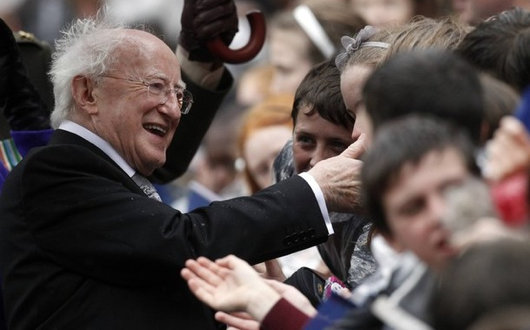
The Inauguration of the President of Ireland
PRESIDENTIAL inaugurations in Ireland were once grand affairs. Viceroys and Governors-General were installed with comparatively little ceremony, the last to hold the latter office having been sworn into office in his brother’s sitting room. Ireland first gained a president in 1938 in accordance with the Constitution adopted at the end of the previous year. (Somewhat awkwardly, Ireland had both a King and a President from 1938 until 1949).
The first President of Ireland was known as An Craoibhín Aoibhinn — “The Pleasant Little Branch” — or Douglas Hyde to give his proper name. An ancient professor whose upper lip was enhanced by a bushy moustache, Prof. Hyde founded Conradh na Gaeilge, the league for the preservation and promotion of the Irish language whose headquarters on Harcourt Street — sorry, I mean Sráid Fhearchair — are just a few doors down from the birthplace of Edward Carson. The Times of London reported thus on Dr. Hyde’s inauguration day:
In the morning he attended a service in St Patrick’s Cathedral presided over by the [Protestant] Archbishop of Dublin, Dr. Gregg. Mr. de Valera and his Ministerial colleagues attended a solemn Votive Mass in the [Catholic] Pro-cathedral, and there were services in the principal Presbyterian and Methodist churches, as well as in the synagogue.
Dr. Hyde was installed formally in Dublin Castle, where the seals of office were handed over by the Chief Justice. Some 200 persons were present, including the heads of the Judiciary and the chief dignitaries of the Churches. After the ceremony President Hyde drove in procession through the beflagged streets. The procession halted for two minutes outside the General Post Office to pay homage to the memory of the men who fell in the Easter Week rebellion of 1916. Large crowds lined the streets from the Castle to the Vice-Regal Lodge and the President was welcomed with bursts of cheering. …
In the evening there was a ceremony in Dublin Castle which was without precedent in Irish history. Mr. and Mrs. de Valera received about 1,500 guests at a reception in honour of the President. The reception was held in St Patrick’s Hall, where the banners of the Knights of St. Patrick are still hung. The attendance included all the members of the Dail and Senate with their ladies, members of the Judiciary and the chiefs of the Civil Service, Dr. Paschal Robinson, the Papal Nuncio at the head of the Diplomatic Corps, several Roman Catholic Bishops, the Primate of All Ireland, the Archbishop of Dublin, the Bishop of Killaloe, the heads of the Presbyterian and Methodist congregations, the Provost and Vice Provost of Trinity College, and the President of the National University.
It was the most colourful event that has been held in Dublin since the inauguration of the new order in Ireland, and the gathering, representing as it did every shade of political, religious, and social opinion in Éire, might be regarded as a microcosm of the new Ireland.
These days much remains the same, though much has also changed. The tradition of Mass and other religious services before the inauguration was dropped in the 1980s when an “inter-faith” service was incorporated into the ceremony itself. Dress remained formal all the way up until the 1997 inauguration of Mary McAleese. The President’s husband, who despised all formal dress, displayed a disgraceful egotism by forbidding them from the ceremony. Gone the morning dress, gone the judges robes and wigs, gone the dignity of the occasion. “Business suits” were the order of the day, and remain so.
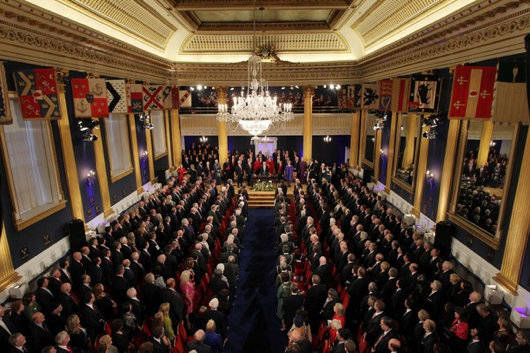
Thankfully the ceremony still takes place in St. Patrick’s Hall, the great chamber of the State Apartments in Dublin Castle. Regrettably, in the 1990s the walls of the hall were lined with French silk in a completely inappropriate shade of dark blue. It gives the unfortunate impression of a New Jersey mobster’s dining room to what would otherwise be a very dignified and stately hall. A light shade of Georgian blue would be much more appropriate.
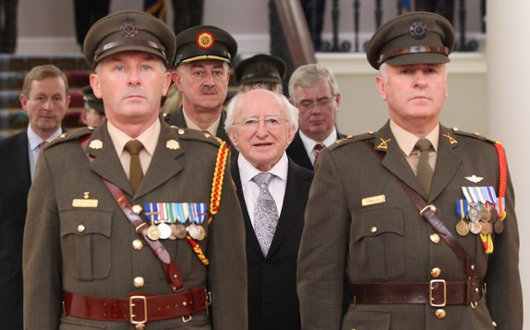
The new president, Michael D. Higgins, is a man of diminutive stature. While one regrets he does not enjoy the correct opinion on most things, he is at least old, and so will bring, one hopes, a certain reflective maturity to the office. The mere sight of him reminds me of my childhood in the 1990s, when the now-President was in the news as culture minister during the ‘Rainbow Coalition’ and the Saw Doctors came out with the song “Michael D. Rockin’ in the Dail for Us”.
The interfaith segment this time was a combination of the truly cringe-worthy and the commendable: an absolute murdering of Be Thou My Vision, prayers and readings from the Catholic Archbishop of Dublin, the Protestant Archbishop of Dublin, a musical rendering of St Patrick’s Breastplate that I actually enjoyed but which seemed more appropriate for a film soundtrack than this event, the Gospel read by the head of the Methodist Church, including the Beatitudes read out by a panoply of multi-culti figures (e.g. a Sino-Irish schoolgirl, a bare-armed deaf woman, a charming African woman in traditional attire, an American man with emotive enunciation in the style of the Evangelical churches). Then the Lord’s Prayer in Irish, a prayer from the moderator of the Presbyterian Church, another from a Quaker woman, and another from a Coptic priest.
Oh mercy, then the cringe-ometer broke with the singing of Make me a Channel of Your Peace. The mayors in their chains of office were markedly unenthusiastic. A reading from the Koran, and a Muslim prayer, followed by the representative of the Humanist Association of Ireland, who looked like she was on some happy-happy pills, read a statement astounding in its vacuousness. Then a musical interlude. Then Enda Kenny spoke, which is always a trial to sit through. (I admit I watched the ceremony later in the day via RTE Player, so I managed to skip that bit).
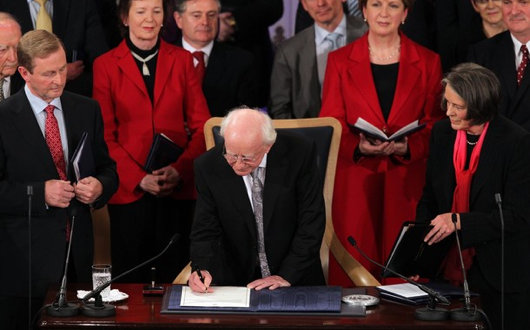
Eventually, having passed through this penitential trial, there was the actual inauguration itself. The Chief Justice — robeless, pace old Mr. (now Sen.) McAleese — administered the Oath as Gaeilge, which the new president then signed (above). The necessary exercises having taken place, the Chief Justice then handed over the Seal of the President of Ireland (below).
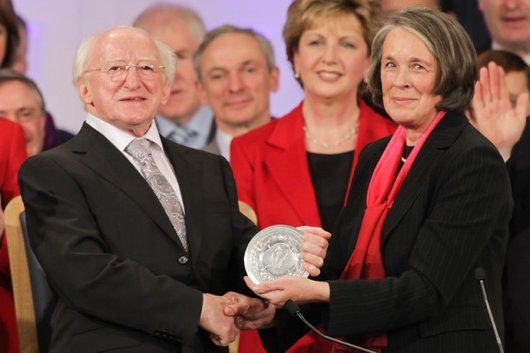
I’ll admit one of the things I hate is how events these days take place for the photographs. In days of yore, events simply took place. A painting or engraving or drawing could be done later, and everything would look grand, whether it was or it wasn’t. Nowadays, the Chief Justice can’t just hand over the seal to the President, she has to hand it over and everyone looks at the camera and smiles. This will be banned when the Counter-Revolution comes! St. Patrick’s Hall will become like those Transylvanian peasant dance halls, where anyone who smiled was expelled, never to be admitted again.
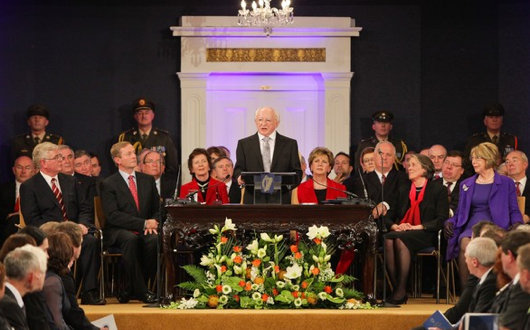
An tUachtarain then graced us with a few words of wisdom.
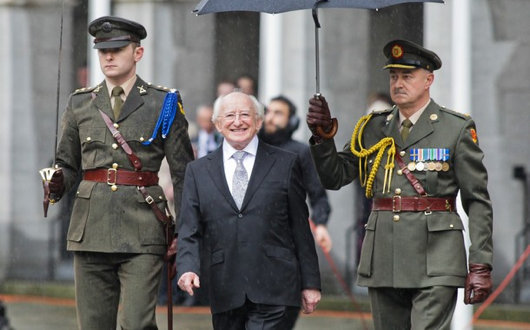
Then came the more fun bit: the presidential review of the troops.
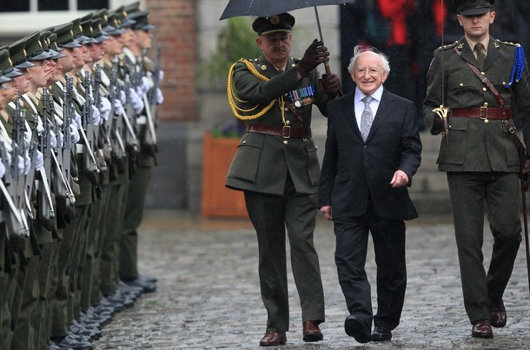
One has to appreciate a nice bit of military pomp, especially in the stately courtyard of the Castle.
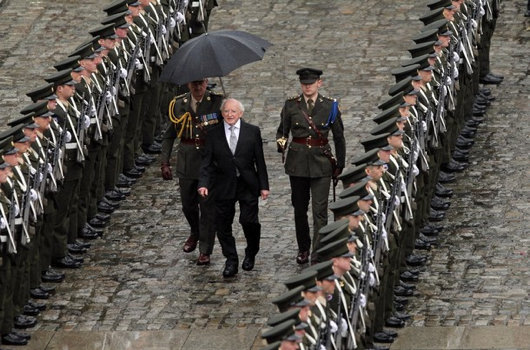
Finally (below), the President & First Lady greeted a crowd of schoolchildren, many of them waving the blue Presidential Standard, before being driven off to Áras an Uachtaráin, the presidential palace in Phoenix Park.
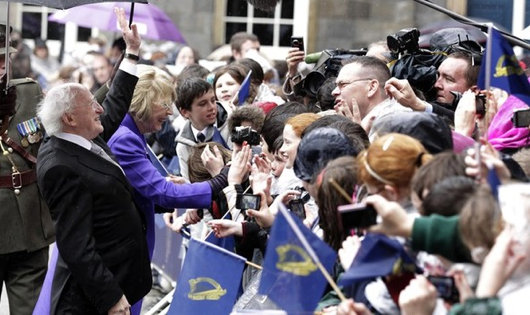
Well, as I said on Twitter: Best of luck to Michael D. Higgins, Uachtarán na hÉireann. Not my first choice, but hope he does the country proud regardless.
Search
Instagram: @andcusack
Click here for my Instagram photos.Most Recent Posts
- Burns Tower April 19, 2024
- Patrick in Parliament March 18, 2024
- Articles of Note: 13 March 2024 March 13, 2024
- Cambridge March 9, 2024
- Taken on Trust March 4, 2024
Most Recent Comments
Book Wishlist
Monthly Archives
Categories



There was some dignity to it when priests, ministers, and rabbis retired to their places of worship and there raised up prayers to God for an incoming Head of State. But to pray serial fashion to God, god, and No God is to invite, not only the scorn of the wise (few though they may be), but also the irked attention of a God who is not mocked.
He has seen your antics, you fools. Prepare to be dealt with, definitively.
When you said the “fun” bit was the review of the troops, I could see that Mr Higgins must agree with you, as he has such a genuine happy expression in those photos.
Too bad they don’t wear formal dress anymore, I think men look so nice and dignified in morning suits, but I have to say I love that the women who stood right behind at the handing over of the seal wore red and black outfits that almost had the look of uniforms or robes of office. Great taste, ladies.
The Church of Ireland cathedral and its Archbishop are Anglican. The word Protestant is usually reserved for Presbyterians and other reformed churches. In the Troubles in Northern Ireland, the conflict was principally between Presbyterian Protestants and Catholics, with Anglicans a small minority not much involved.
Traditionally we Catholics refer to those denominations that emerged from the Protestant Reformation as Protestant (thus including Anglicans).
In Ireland, however, there is a big distinction. The Protestants of Northern Ireland see themselves quite separate from the Anglicans.
Anglicans in England and most Episcopalians do not see themselves as Protestant, but rather the via media.
Cromwell was a Protestant and certainly not an Anglican.
Henry VIII was given the title Defender of the Faith by the Pope for defending the Catholic faith from Luther.
If you agree to call Anglicans by their chosen name, then we will agree to call you Catholics and not Roman Catholics, which is what most of the English say!
BTW, the Episcopal Diocese of New York chose a new Bishop Coadjutor today, Canon Andrew Dietsche.
At least we can agree that he has a very nice Christian name,
Having gone to university with a number of Northern Irish Protestants of varying denominations (Presbyterian, Anglican, Quaker, and house churches) I am familiar with the situation.
Of course, I do agree to call Anglicans “Anglicans” since that is the appropriate subset within the term “Protestant”. No one is accusing the Protestant Archbishop of Dublin of being a Methodist or a Quaker! As to whether Latin-rite Catholics are referred to as “Catholics” or “Roman Catholics”, I’m not terribly concerned one way or the other.
Anglicanism as ‘via media’ is a rather charming (if admittedly ridiculous) idea that showed up on the scene in the 19th century, well after the foundation of the Anglican Church three hundred years earlier. Anglicanism is composed of the different kinds of Anglicans: chiefly low-church evangelical Protestants and broad- & high-church liberal Protestants. But they’re all still Protestant.
One does of course recall that in the United States, the legal name of the Episcopal Church is the “Domestic and Foreign Missionary Society of the Protestant Episcopal Church in the United States of America”. In England, meanwhile, the Supreme Governor of the Church of England swears an oath to maintain the “Protestant Reformed religion”.
I do understand that some Protestants pretend not to be Protestant, but I’m sure they won’t be offended if the rest of us smile and nod and carry on regardless. The Protestantism of Anglicanism is beyond doubt, even if some Anglicans find it personally discomforting.
You are , of course, completely correct Mr Cusack.
The current settlement in Anglicanism indeed dates to the Reformation, but the Church of England itself was founded by Augustine. It didn’t cease to exist at the Reformation and then become created anew. It was reformed. If a man is reformed he has not died and we are not talking about someone who just looks like him.
Of course this gets us into what makes a church etc., something on which we various strains of Christianity shall have to disagree on for now. But if you’re calling Anglicanism Reformed (which it is), and Protestant (which it is), you can’t really suggest there was nothing there that was reformed and then continued …
When the Church of Rome reforms itself according to the Holy Scriptures, it shall still be the Church of Rome, but, praise God, Reformed and Protestant.
You can, actually, because you can say a Reformed Church is not necessarily a church which has undergone reform but rather an ecclesial grouping subscribing to Reformed (or Protestant) Christianity. Your point about a reformed man (a man who has been reformed) is valid, but a Reformed man (a man who is Reformed, as in Protestant) may have been been Reformed his whole life. It’s a matter of a common adjective versus a proper adjective.
The English church was founded by Augustine, but the corporate body today known as the Church of England is, of course, not the same entity.
Protestant is a word with a rich heritage in Ireland or one that carries a lot of baggage (whichever you prefer). Historically neither Methodists nor Presbyterians were Protestant since only those who conformed to the Protestant Church by law Established counted as such. It’s an old-fashioned usage but still just about current to use Protestant to describe Anglicans rather than Methodists or Presbyterians. Obviously this is a dead letter, stricto sensu, since the 1869 Disestablishment Act.